This page was generated from `/home/lectures/exp3/source/notebooks/L27_AMA/L27_potential_well.ipynb`_.
A potential well¶
… with infinite high walls¶
Now we want to discuss the case that a particle is only allowed to be located within a defined space. This case can be constructed by means of a potential well like
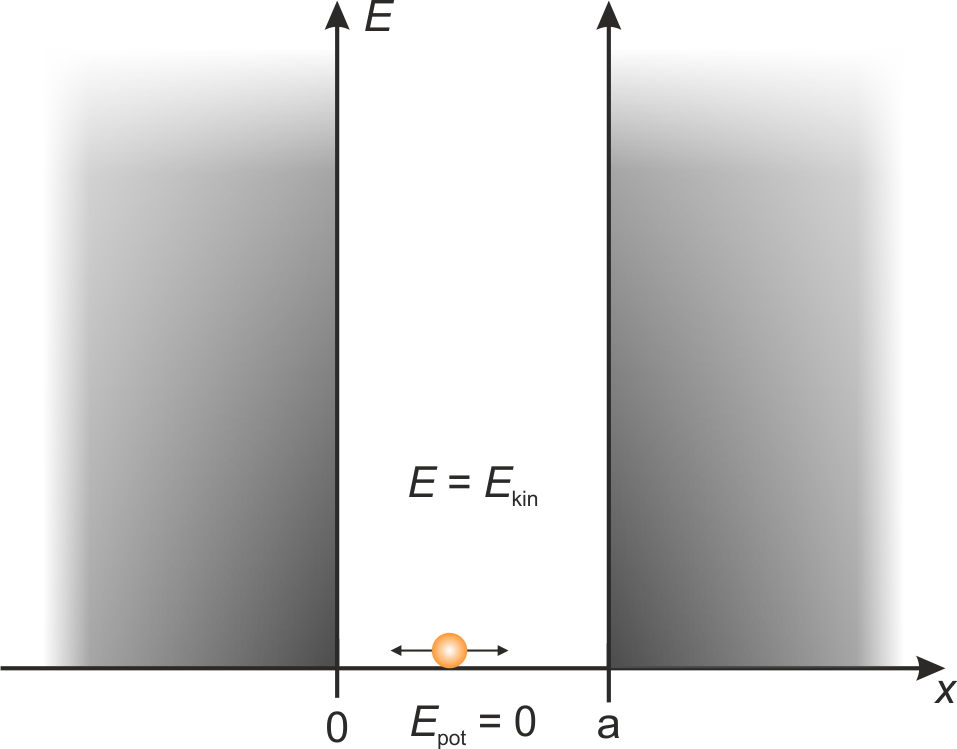
Fig.: A particle within a potential well with infinitely high walls.
Because the potential energy outside the potential well is infinite, it follows for the decay length
and for the decay of the matter wave
Thus, the penetration depth of the matter wave vanishes and we have “a particle in a box”. Within the region
and the solution for the position-dependent amplitude
Because the potential energy outside the box approaches
and obtain
On the basis of the first condition (
and on the basis of the second condition (
We refine the wave function further resulting in
with
respectively.

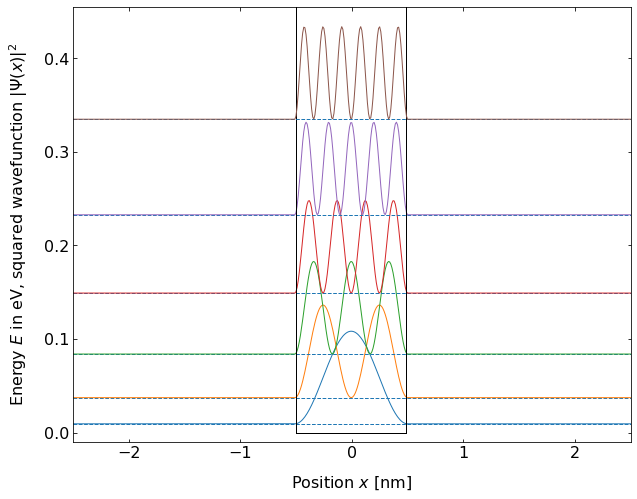
Fig.: (left) Wave functions :math:`psi_{mathrm{n}}` positioned at the height corresponding to the energy eigenvalue :math:`E_{mathrm{n}}`. (right) The according probability densities (squared wave functions). The postential is :math:`0` for :math:`-0.5 , mathrm{nm} le x le 0.5, mathrm{nm}`, otherwise it is set :math:`10^4 ; mathrm{eV}`
As the values that the wavenumber and wavelength can adopt are restricted in accorded to the boundary conditions, we are wondering how the energy of the particle might be affect. For the energy we can write
and we see that our particle in the box cannot adopt any arbitray energy. In order to remain at a stationary state the particle can adopt only specific, descrete values of energy. Thus, the energy eigenvalues or energy principal values are quantized. We can state the energy
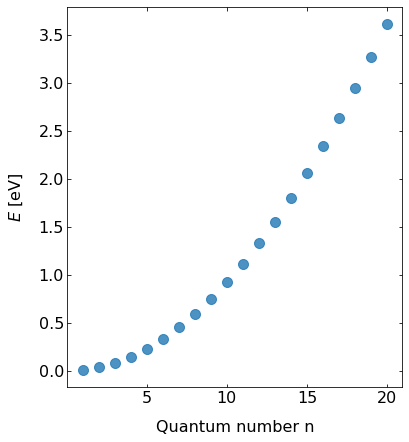
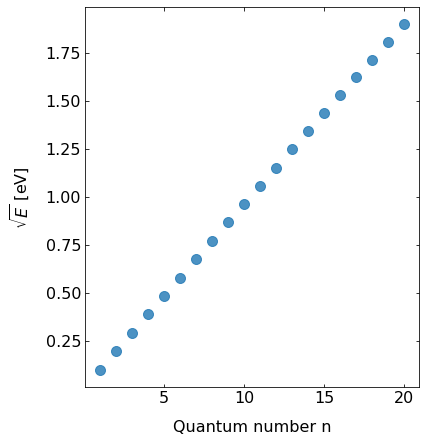
Fig.: (left) The energy eigenvalus in dependence of the quantum number :math:`n`. (right) The square root of the energy eigenvalues from the left panel in dependence of teh quantum number form a straight line, because of the :math:`E_n = E_1 cdot n^2` relation. The postential is :math:`0` for :math:`-0.5 le x le 0.5`, otherwise it is set :math:`10^4`
It is evident that the energy eigenvalues rise with the square of the quantum number (
Only for an infinitely wide potential well
… with finite high walls¶
If the walls of the potential well are not of infinit height, the wave function might penetrate into the walls (
Because the wavefunction is able to intrude into the walls, the position uncertainty
In oder to resolve the eigenstates, we state the general solution for the wave function in the regions as follows:
with
with
where
If we now apply the boundary conditions at
we get
respectively. From the boundary conditions at
we get
If we divide the last equation by the second last and make use of
which has the two solutions for
On the basis of this solutions and the relations
These solutions for the energy eigenvalues
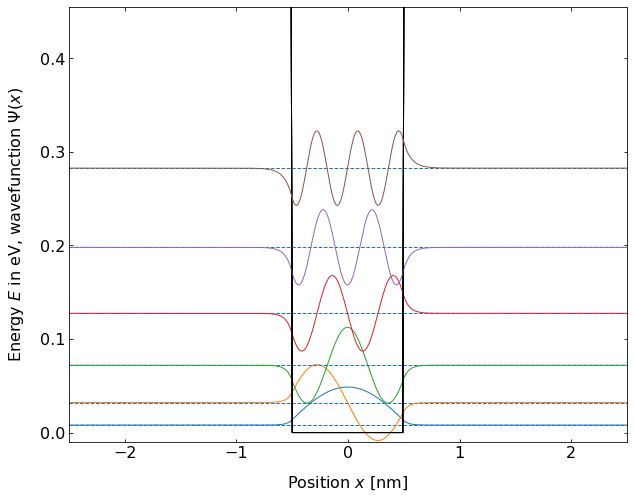

Fig.: (left) Wave functions :math:`psi_{mathrm{n}}` positioned at the height corresponding to the energy eigenvalue :math:`E_{mathrm{n}}`. (right) The according probability densities (squared wave functions). The postential is :math:`0` for :math:`-0.5 , mathrm{nm} le x le 0.5, mathrm{nm}`, otherwise it is set to :math:`0.5 ; mathrm{eV}`
In the case of an infinite deep potential well (
If the energy of the particle is greater than the depth of the potential well (
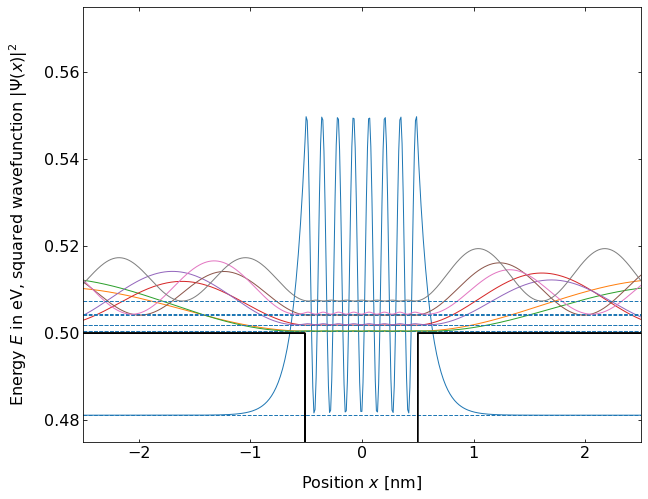
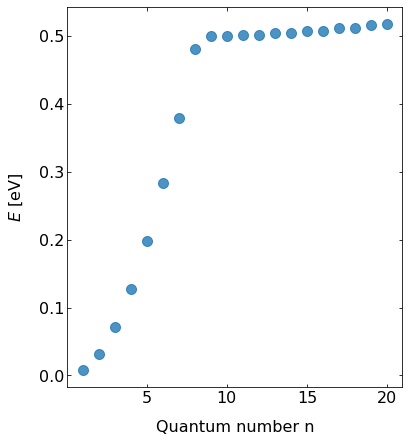
Fig.: (left) The probability densities :math:`left| psi_{mathrm{n}} right|^2` positioned at the height corresponding to the energy eigenvalue :math:`E_{mathrm{n}}` in the case of teh last bound state (:math:`n = 8`) and the next seven states. (right) The energy eigenvalues in dependence of teh quantum number. The postential is :math:`0` for :math:`-0.5 , mathrm{nm} le x le 0.5, mathrm{nm}`, otherwise it is set to :math:`0.5 ; mathrm{eV}`- Please not that the representation of the continuous states is only ofexemplary nature. The data are the actual results from the very same calculations as for the bound states. However, the description of the continuum might suffer from numerical resolution and calculation accuracy.
